What's
It About,
How I Photograph It
There has been a revolution when it comes to fashion,
style and the human body. Muscle has suddenly become chic. This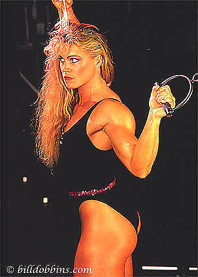 -began
with men, and now includes women. Suddenly there is worldwide interest
in women with muscles, female bodybuilders and women with sexy, lean muscular
bodies.
-began
with men, and now includes women. Suddenly there is worldwide interest
in women with muscles, female bodybuilders and women with sexy, lean muscular
bodies.
This trend appeared first in the movies. Nobody was ever as lean, muscular and “ripped” as martial arts legend Bruce Lee. Sylvester Stallone trained with a champion bodybuilder to create the sculpted physique we saw in Rocky II. Arnold Schwarzenegger, by far the greatest bodybuilder of his day, appeared on screen in Conan The Barbarian and raised the bar even further. Nowadays, no self-respecting action film hero could expect to make much of an impact without a hardbody and a great set of abs. People watch Jean Claude Van Damme for his physique, not his acting. You can’t even make it as a male fashion model these days without the highly defined pecs and abs of a young, aspiring bodybuilder.
Since the late 1970s there has been a gradual acceptance of female muscle as well, due in large part to the example of women’s bodybuilding. Before the advent of modern bodybuilding for women, even female Olympic athletes were rarely that muscular. People admired the muscular legs of female dancers, but not their deltoids or biceps. “Warrior women” in the movies were starlets with big hips and breasts, not hard, athletic and muscular physiques. Tits ‘n ass was the name of the game, not pecs ‘n glutes.
As we enter the 21st century, women’s bodybuilding is flourishing all over the world. Hundreds of young female physique competitors from dozens of countries gather each year for the World Women’s Amateur Bodybuilding Competition, sanctioned by the International Federation of Bodybuilders. The United States has long taken the lead in bodybuilding for women, followed by Germany and the Scandanavian countries, but now we see an increasing participation in the sport by women from Eastern Europe and Asia. You rarely see this reported in the major newspapers, magazines or on mainstream international television. But go to Columbus, Ohio in March, when Arnold Schwarzenegger holds his annual Ms. International Bodybuilding Championship or attend the IFBB Olympia Weekend each October in Las Vegas, where female bodybuilders compete for the prestigious Ms. Olympia title, and the size and enthusiasm of the growing world-wide audience for female physique will be evident.
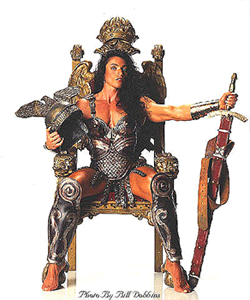 The
example of female bodybuilders has had a profound - if largely unrecognized
- effect on the culture as a whole. The “hardbody” is
becoming increasingly sexy. In Terminator II, the audience was more
impressed with Linda Hamilton’s muscles than Arnold’s. Angela
Bassett was more muscular in What’s Love Got To Do With It than Tina
Turner ever imagined being. Female “pro wrestlers” with
bulging biceps are not only worshipped by a growing international audience,
but the World Wrestling Federation’s “Chyna” was given
a cover and a pictorial by the US edition of Playboy. Supermodels
are doing workout videos. Female VJs on MTV have to have well defined
abs and tight athletic bodies. Young socialites in New York hire
personal trainers so they can participate in the trend toward female muscle
chic.
The
example of female bodybuilders has had a profound - if largely unrecognized
- effect on the culture as a whole. The “hardbody” is
becoming increasingly sexy. In Terminator II, the audience was more
impressed with Linda Hamilton’s muscles than Arnold’s. Angela
Bassett was more muscular in What’s Love Got To Do With It than Tina
Turner ever imagined being. Female “pro wrestlers” with
bulging biceps are not only worshipped by a growing international audience,
but the World Wrestling Federation’s “Chyna” was given
a cover and a pictorial by the US edition of Playboy. Supermodels
are doing workout videos. Female VJs on MTV have to have well defined
abs and tight athletic bodies. Young socialites in New York hire
personal trainers so they can participate in the trend toward female muscle
chic.
Nonetheless, the sport of women’s bodybuilding, particularly at the pro level, has continued to create controversy. Over time, they have continued to get bigger, harder, more muscular and more defined, as happens when a group of genetically gifted individuals train intensely with weights for 10, 12 or 15 years. Muscle for women is one thing - but this much stunningly visual muscle is quite another. Over and over, just as the culture seems to be getting used to the mass and muscularity of the top women pros, they move on to yet another level.
People quite often will admire a female muscular physique like that of Madonna - who can be when she chooses far more muscular than any superstar diva who preceded her - while at the same time being repulsed by the competitive female bodybuilders who have inspired Madonna and other women to develop such muscular and athletic bodies. In many cases, women bodybuilders seem to have won the battle but lost the war. They have revolutionized the culture but don’t get credit for it.
Contrary to expectations, people don’t believe what they see as much as they see what they believe. Preconceptions regarding female muscle get in the way of seeing and understanding what is actually going on. There are women with ugly muscles, just as there are muscular men who are not at all aesthetic. The fact that they exist doesn’t make them typical - nor representative of bodies you’ll find in a sport based on athletic aesthetics. Women’s bodybuilding should be evaluated based on the best in the sport, not the worst. When you think golf you picture Tiger Woods, not some duffer who can’t break 100.
Ironically, people usually have a very different opinion when they actually see an attractive female bodybuilder, lean and shapely, walking through a shopping mall or along the street, wearing a tight skirt and high heels. Women like this stop traffic. Or a “hardbody” fitness competitor showing off her sculpted abdominals in a television commercial for sports equipment. The public also admires the physiques of a variety of female athletes such as Olympic sprinters, who have developed all that muscle with weights, not simply by running.
This ambivalent attitude toward the “hyper-muscular” female physique may well be a holdover from the Victorian view of women as weak and helpless creatures whose survival depended entirely on finding a strong man to protect them. This view was in large degree a product of the Industrial Revolution, which produced a growing human reliance on machines rather than muscle, and the subsequent growth of the urban middle-class, which was far more interested in “propriety” than were the aristocrats or the industrial age poor.
But this view was a cultural fiction. Most human
beings throughout history have been peasant farmers and a farmer’s
wife 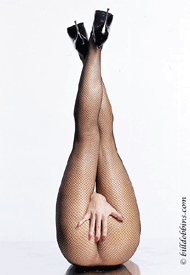 has
to be a long way from helpless. Women had to be strong in order to
survive - plus they had to have babies as well. They certainly weren’t
inclined to faint when faced with crisis like the heroines of Victorian
melodrama.
has
to be a long way from helpless. Women had to be strong in order to
survive - plus they had to have babies as well. They certainly weren’t
inclined to faint when faced with crisis like the heroines of Victorian
melodrama.
But the “celebration” of the muscular body is part of a different tradition. It arose as the idea of athletic competition evolved, which eventually resulted in a professional class of competitive athletes who were free to dedicate their time and resources to building harder, leaner and stronger bodies. The pro athletes who competed in contests such as the ancient Olympic Games developed bodies were highly aesthetic as well as capable of superior performance. Their bodies became the subject of art, hence the surviving sculptures from ancient Greece of lean, muscular male physiques not to be equaled until the time of Michelangelo and the Renaissance.
Of course, the idealized athletic physiques in Greece and subsequent eras were always male. The female body was depicted as soft and yielding, symbolic for the most part of concepts such as love, sex, and motherhood. Even female warrior goddesses were not presented as having lean and muscular athletic bodies. Muscular women would have been considered unfeminine or even unnatural. In the original myth of the Amazon, these warrior women were depicted as cutting off a breast in order to improve their skill with a bow, a very clear metaphor for the idea that exercising skills appropriate to the male robbed a woman of her feminine identity.
But we are in a time in which muscle-power has lost most of its practical and survival functions. How does that affect our view of the human body? Canadian communications theorist Marshall McLuhan (“The Medium Is The Message”) told us in the 1960s that things become fully available as art once their primary practical purpose is rendered obsolete. Thus the concept of “art for art’s sake” and the idea the nature of painting be the primary subject of painting only came about in the 19th century after the invention of photography.
The development of modern bodybuilding can be seen as an illustration of this principle. It was only in mid-20th century, when machines had come to dominate in areas where once we relied primarily on human muscle power, that a sport emerged in which the muscles of the body are developed primarily for aesthetic purposes - and are judged on the basis of mass, shape, proportion, symmetry, detail and definition, without regard to performance or functionality.
Bodybuilding is concerned with how the body looks rather than what it is capable of doing. As a competition involving aesthetics as opposed to action (although competitive posing is difficult and requires a great deal of practice and expertise), it is both a sport and a specialized art form. While traditional sports are based, somewhere in the distant past, on testing warrior skills, bodybuilding is totally about the aesthetics of the body. It is true that the kind of progressive resistance weight training bodybuilders have invented over the past five decades has become the basis for the training programs used by a wide variety of athletes, for rehabilitation of injuries and the training method used by millions who join gyms to build, sculpt and strengthening their bodies (whether they call it bodybuilding or not), the competitive bodybuilding physique has no practical purpose other than “showing off.” In that sense, it is more like a peacock’s tail, display rather than performance.
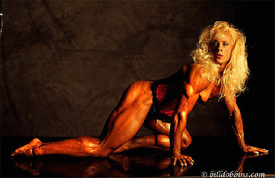 But
even though competitive bodybuilding is a growing international phenomenon,
it is not a sport that is easily accepted in modern culture. It is
one thing to admire the beauty of a statue, another to look at an actual
body - especially when it is a nearly nude male body - from the same point
of view. This makes a lot of people uncomfortable. It strikes
many as bizarre, even perverse. Bodybuilders are often seen as immersed
in an unhealthy narcissism. They are thought to be homosexual, or
primarily appealing to homosexuals. Because they are not training
to excel at normal athletic competition, they are viewed as “muscle
bound” and not really capable athletes at all. It is acceptable
to admire the muscles of somebody who “does something” with
them, but not acceptable to admire the same kind of body that was developed
simply so that people could admire it.
But
even though competitive bodybuilding is a growing international phenomenon,
it is not a sport that is easily accepted in modern culture. It is
one thing to admire the beauty of a statue, another to look at an actual
body - especially when it is a nearly nude male body - from the same point
of view. This makes a lot of people uncomfortable. It strikes
many as bizarre, even perverse. Bodybuilders are often seen as immersed
in an unhealthy narcissism. They are thought to be homosexual, or
primarily appealing to homosexuals. Because they are not training
to excel at normal athletic competition, they are viewed as “muscle
bound” and not really capable athletes at all. It is acceptable
to admire the muscles of somebody who “does something” with
them, but not acceptable to admire the same kind of body that was developed
simply so that people could admire it.
Competitive bodybuilding has been around “officially” since the 1940 AAU Mr. America contest, although various kinds of physique contests were held long before that. But starting in 1977, a new type of sports competition emerged - bodybuilding for women. Of course, the early women bodybuilders weren’t all that big, certainly compared to what was to follow. Their little muscles were often considered “cute” - at least if they were otherwise conventionally attractive. But people have very deeply held ideas of gender identity (hence the anger often directed at “gender outlaws” like homosexuals and transsexuals) and what the body is supposed to look like. So while the women bodybuilders were initially well received, as they gradually got bigger and more muscular they began encountering increasing hostility and resistance - both from inside the sport and from without.
While everybody loves kittens, not everyone likes cats.
The hyper-muscular female bodybuilder was really “something new under the sun.” There was no historical tradition of women developing their muscles for aesthetic purposes as there was for men. There was no cultural precedent. These women represented, according to Charles Gaines, author of Pumping Iron, a “new archetype.” Thus bodybuilding for women encountered and created cultural opposition and controversy that is still with us today after some 25 years.
My own involvement with the sport of bodybuilding for
women was strictly a matter of “right place, right time.” I
did not 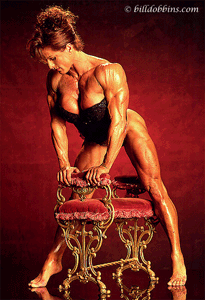 grow
up, as did many of my colleagues, as somebody fixated primarily on the
athletic female body. I was working for Joe Weider’s Muscle & Fitness
Magazine in the late 1970s when the women began competing. Bodybuilding
was a sport, I reasoned, in which men and women both participate - just
as they do in tennis, golf, track, basketball and most other forms of athletics. So
I began shooting the women and covering their contests without giving it
much thought. The idea that there was something wrong with women
being bodybuilders, that what they were doing was “unfeminine” or
unnatural never occurred to me - and more than it would have when I had
occasion to report on any other sports competition for women.
grow
up, as did many of my colleagues, as somebody fixated primarily on the
athletic female body. I was working for Joe Weider’s Muscle & Fitness
Magazine in the late 1970s when the women began competing. Bodybuilding
was a sport, I reasoned, in which men and women both participate - just
as they do in tennis, golf, track, basketball and most other forms of athletics. So
I began shooting the women and covering their contests without giving it
much thought. The idea that there was something wrong with women
being bodybuilders, that what they were doing was “unfeminine” or
unnatural never occurred to me - and more than it would have when I had
occasion to report on any other sports competition for women.
Besides, being a bodybuilding fan and liking the aesthetically developed muscular physique in general, I thought they looked pretty damn good.
Over time I began to appreciate the greater significance of what these women were doing and to appreciate the social and physiological questions that their success raised. If at least some women build muscle so relatively easily, why hadn’t they done it before in all of history? How did history overlook this capacity of the female body so completely and for so long? Why is it many people greet the idea of otherwise attractive women with a lot of muscle with anger and hostility rather than simple indifference? What are they so upset about? Furthermore, isn’t this just another example of artificial limits being put on women’s abilities? The same kind of arbitrary limitation that women have fought against in politics, business, science, sport and so many other areas of modern life over the past 100 years?
Actually, bodybuilding for women does seem to fit very well into the timeline of developing gender equality throughout the 20th century. Women began by getting the vote. They moved into science, law and business. There were gradually accepted as serious athletes. At the end of the century they assailed the final wall of resistance - the nature of “femininity” as regards their own bodies. In many ways this has been the toughest obstacle of all, and the struggle is still going on.
When I began shooting female physiques I was already very familiar with the aesthetics of bodybuilding. So I had no trouble appreciating what they were doing right from the start. Once I began working with the women, I quickly became conscious of having a unique opportunity as an artist. I had access to a type of human body never before seen on the planet. It is extremely rare to discover a truly new subject. Even though the human body had been depicted in art for thousands of years, every image I created of these bodies would be “new” because the bodies were new. I could create entirely unique images, or I could go back to familiar themes and create wonderful artistic tension by contrasting a new kind of physique with a familiar and recognizable tradition.
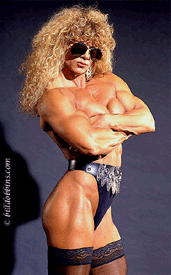 However,
I quickly discovered that most people can’t really “see” the
aesthetics of the female bodybuilding physique. They lack the necessary
references and experience. So I see my work as a way to “interpret” these
bodies in such a way that viewers are able to perceive what the aesthetics
involved are all about. Frequently, it is much easier for most to
appreciate the nature of the aesthetically developed female body in photographs
than looking at the same bodies in person. I am very gratified when
somebody looks at my pictures of these women and says, “Ah, now I
get it.”
However,
I quickly discovered that most people can’t really “see” the
aesthetics of the female bodybuilding physique. They lack the necessary
references and experience. So I see my work as a way to “interpret” these
bodies in such a way that viewers are able to perceive what the aesthetics
involved are all about. Frequently, it is much easier for most to
appreciate the nature of the aesthetically developed female body in photographs
than looking at the same bodies in person. I am very gratified when
somebody looks at my pictures of these women and says, “Ah, now I
get it.”
I am frequently asked what I do when shooting these pictures that is different from most other physique photographers. One thing I’ve noticed is that many photographers are interested in making these bodies accessible by emphasizing what is conventionally attractive about them. Making them look as “normal” as possible. But what interests me most is what is unique about them. I focus on what is different about these physiques, not what is similar to bodies we are already familiar with.
I often like to photograph the hyper-muscular female physique is as if I were shooting a landscape. The muscular female body is to me what Yosemite was to Ansel Adams. I often shoot at desert, mountain or beach locations, where the land is hard and harsh and the bodybuilding physique becomes an extension of the environment. I also like to create visual tension by posing my subjects in attitudes or situations that call to mind and contradict established visual concepts. For example, an attractive, muscular women in sexy lingerie - but with her arm fully flexed, creating a conflict between her curvaceous feminine form and the mass and definition of her biceps and triceps.
Over the past two decades, I have listened to constant predictions of the “death” of female bodybuilding, both as a sport and as a socially acceptable activity. Unfortunately, some of these warnings have come from officials in the bodybuilding federations, whose responsibility should be to promote the women, not to hold them back. But despite this negativity, there are more women training with weights all the time. Fortunately, my work is well known enough that many of these women seek me out for photo sessions, so I continue to have access to the best female physiques in the world. Despite the controversies involved, the idea that beautiful muscle makes an attractive woman even more attractive is continuing to gain ground in our culture and in time the female bodies many today view as being “too extreme” will be looked back on as quaint and old fashioned.
The physique federations recently developed something called “fitness” competition. This involves competition among women with some muscle - but not too much - plus the ability to do some kind of athletic performance, which usually means a lot of gymnastics for those hoping to score well or win. Some of these competitors have so much muscle they should be bodybuilders. I find it ironic that many successful fitness competitors, considered “feminine” and attractive, have more muscle than did many early female bodybuilders who were constantly accused of “looking like men.” Our culture tends to get used to extremes very quickly. While fitness competitors are not as developed as the champion female bodybuilders, many have quite beautiful, muscular bodies. I have enjoyed photographing many of them, and their photos are also included in this book.
Fitness was created, in part, to develop a group of women who were not too muscular for popular, conventional taste. It was thought female bodybuilders were going “too far.” Actually, accusing female bodybuilders of “going too far” or “becoming too extreme” is to contradict the very nature of bodybuilding. Bodybuilding is about the extreme aesthetic development of the body just as opera is about the extreme aesthetic development of the voice. To be a good opera singer, it isn’t enough to sing loud. The sound you make also has to be beautiful - by the standards of opera, not by those of pop music. A bodybuilder has to have big muscles, but that isn’t enough either. The muscular body also has to be beautiful - by the standards of bodybuilding, not those of conventional views of GQ, Vogue or even Playboy.
So bodybuilding can be understood as the grand opera of the human physique. And as far as making photographs of these bodies is concerned, in my view the more extreme the better.
Personally, I can’t wait to see what happens next. There is no limitation to the development of the bodybuilding physique other than genetics and aesthetics. If women in bodybuilding follow the same growth curve over time as have the men we will eventually see female competitors much bigger, hard, denser, more muscular and more defined that those of today. But they will still be shapely, symmetrical and proportioned. They will have wide shoulders and a small waist. Their muscles will be full and taper down to small joints. The best will combine beauty of physique with overall aesthetics, including beautiful faces.
Hopefully, I will be around to continue to photograph them.